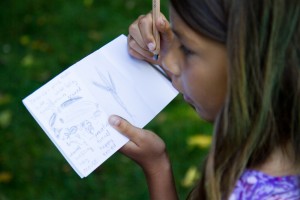
In this blog I want to share some advice for teaching kids to draw. I’ll share some advice I have gathered over a few decades teaching all ages to draw and illustrate.
Why Observation Is Important
One of the first things I like to teach my students is the fundamental concept of art observation. This significant word, ‘observation,’ is important for developing drawing skills. Kids begin to grasp the importance of observing and closely examining objects with an artistic eye. This is where the term ‘look with artist’s eyes’ originates. It implies examining all the details such as lines, shapes, colors, and visible patterns.

Line, shape, and texture are just a few art elements of design that can be observed in objects. It takes time to teach students to pause and look at the elements that create images. Once children become familiar with these basic elements, drawing becomes easier for them. In fact, they can learn to replicate desired images by examining the fundamental elements they see. With lots of practice, children become adept at observing their subject. And then they can identify related elements to help them begin to create similar marks with drawing mediums.

Teaching Kids to Draw Basic Shapes
Start drawing lessons with basic organic or geometric shapes. Most children can relate to a basic shape they’re already familiar with, like a circle or square. To help kids draw a chosen subject matter, ask them to identify a similar shape or form that looks close to what they are trying to draw.
Here’s an example of what I mean:
When I teach children how to draw the human eye, I point out that the basic shape I see is similar to the shape of an upside-down football. This helps kids begin with a basic outline that is not too difficult to draw. Then, we talk about the iris shape inside, which I relate to a round basketball shape. This usually helps my students get past the daunting idea of drawing a perfect eye. You can assist them in breaking down the steps to draw an eye shape without feeling frustrated about where to start. Observation of shape and form is the first step to drawing.

What age can kids learn to draw?
Elementary-grade students can begin observing and drawing basic images. Generally, children who are learning to write the alphabet can also comprehend some basic line drawing instructions. Their drawings improve as they gain better fine motor control. While their drawings may not achieve sharp precision initially, with consistent practice, they can develop good control in rendering the simple details they observe.
Drawing is a natural skill that can be cultivated, much like learning to write letters or ride a bike. When providing guidance, it’s important to avoid expecting perfect drawings from children. Believe it or not, I frequently have parents inquire about why their child’s drawings lack clarity or detail. Remember, it all comes down to practice, practice, and more practice.”

Kids Learn to Draw Using Three Senses
During my 30 years of teaching kids of all ages how to draw and paint, I’ve identified three senses that significantly support the development of these skills. The key areas that influence children’s ability to draw are:
1. Cognitive Processing
2. Visual Perception
3. Fine Motor Movement
Another important insight I’ve gained is that children typically take a longer time to fully develop these three senses. Essentially, children don’t initially perceive things the same way adults do; it takes years to acquire this level of knowledge. However, children can learn to observe and pay attention to details over time. If you’re interested in delving deeper into my sensory art method™ and how to teach these skill sets, you can find more information in my books.
In this blog, I’ve shared my top tips for nurturing children’s drawing skills, emphasizing the importance of starting with familiar shapes to make detailed drawing more easy. To dive deeper into my natural art method, you can explore more of my blogs on this topic or access valuable insights in my art education books, available through the links. Thank you for taking the time to read and explore!”
Unlock a comprehensive list of drawing lessons ideas tailored for lower and elementary school children by simply downloading our free PDF:
One step further, order my drawing curriculums: Drawing Curriculum For Teaching Your Students



All rights reserved © 2025, Nature of Art®

No part of this blog may be used or be reproduced in any manner whatsoever including reproducing, publishing, performing, and making any adaptions of the work – including translation into another foreign language without written permission except in the case of brief quotations embodied in critical articles and reviews. Nature of Art® Publishing P.O. Box 443 Solana Beach, California 92075.




